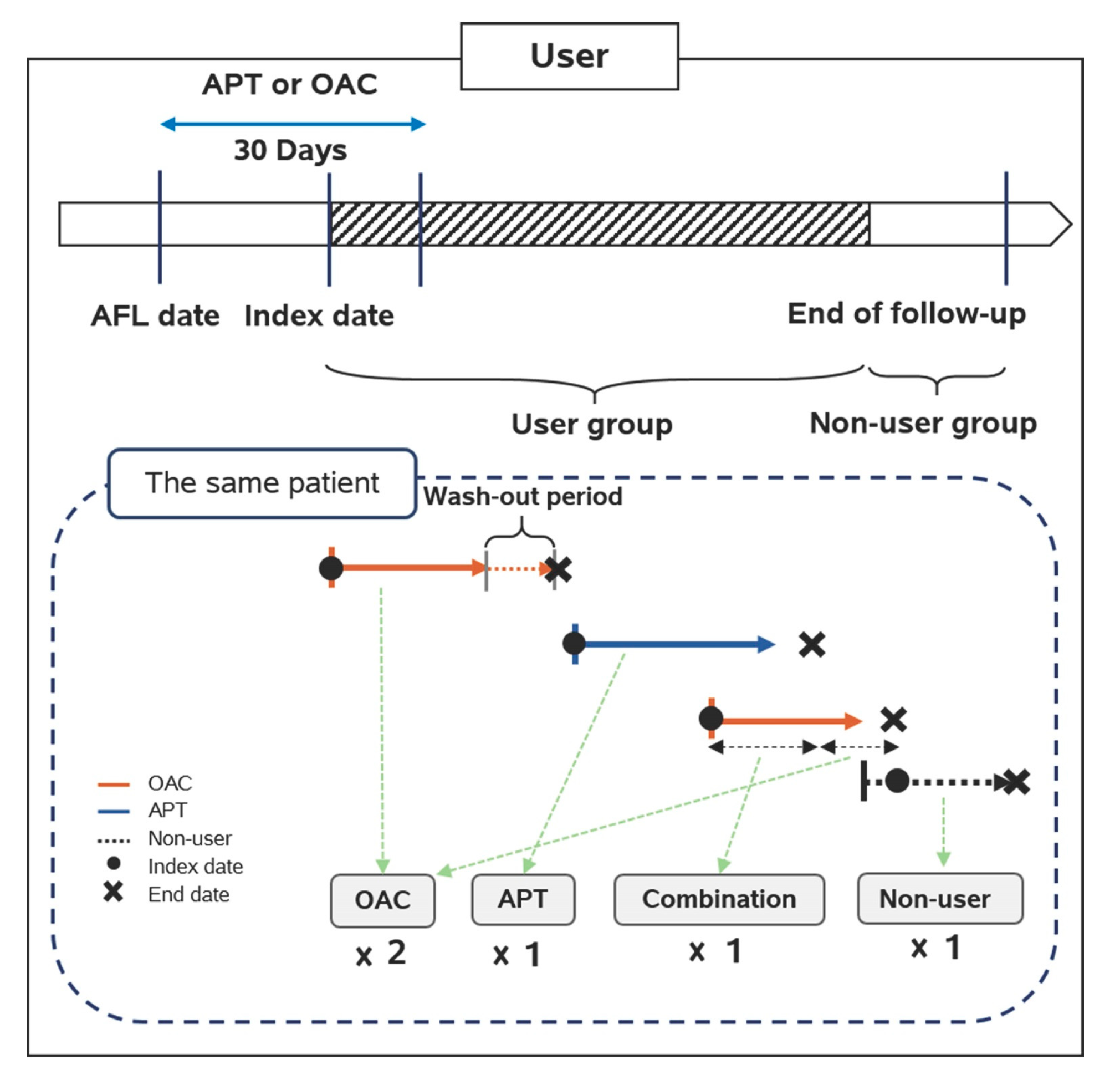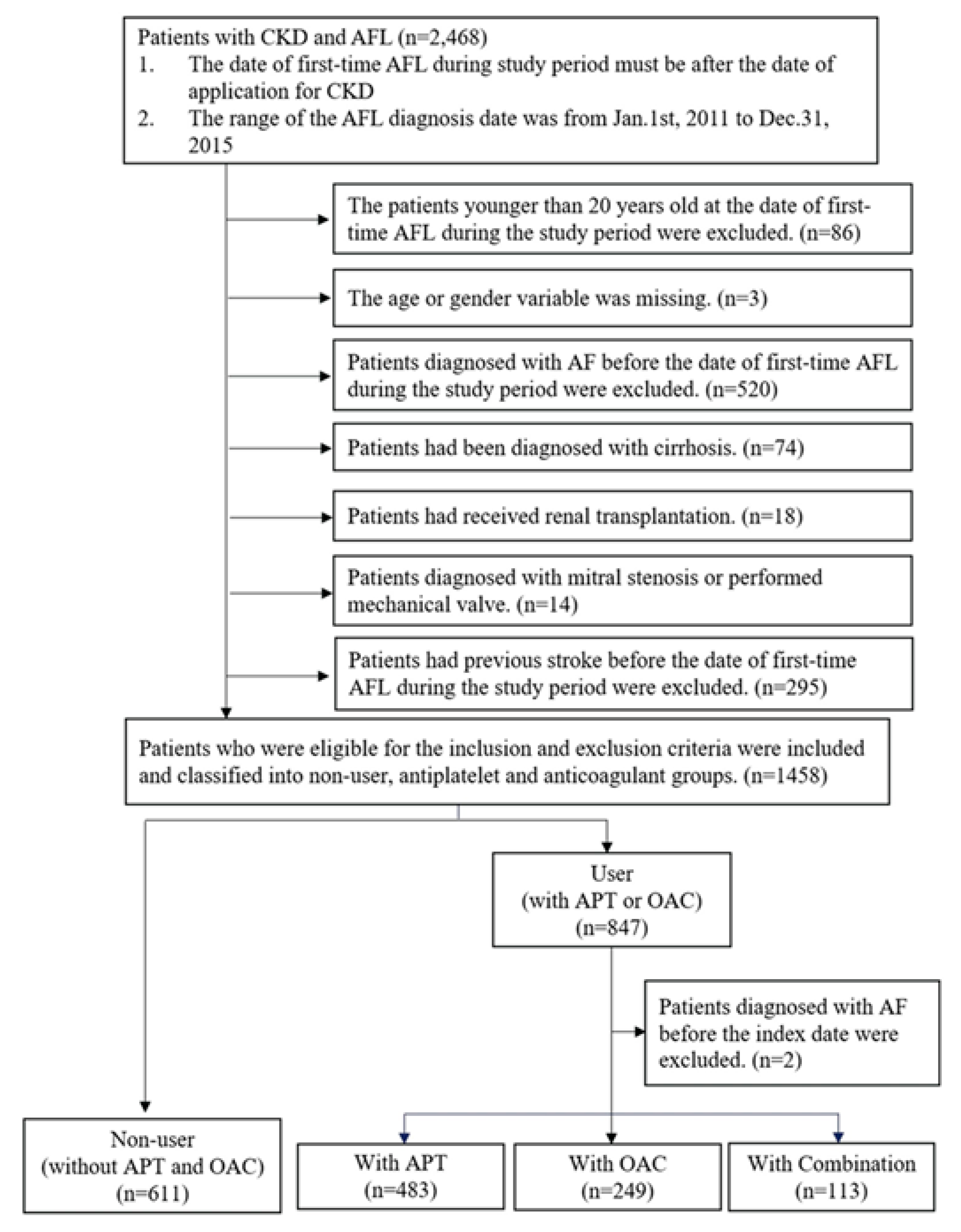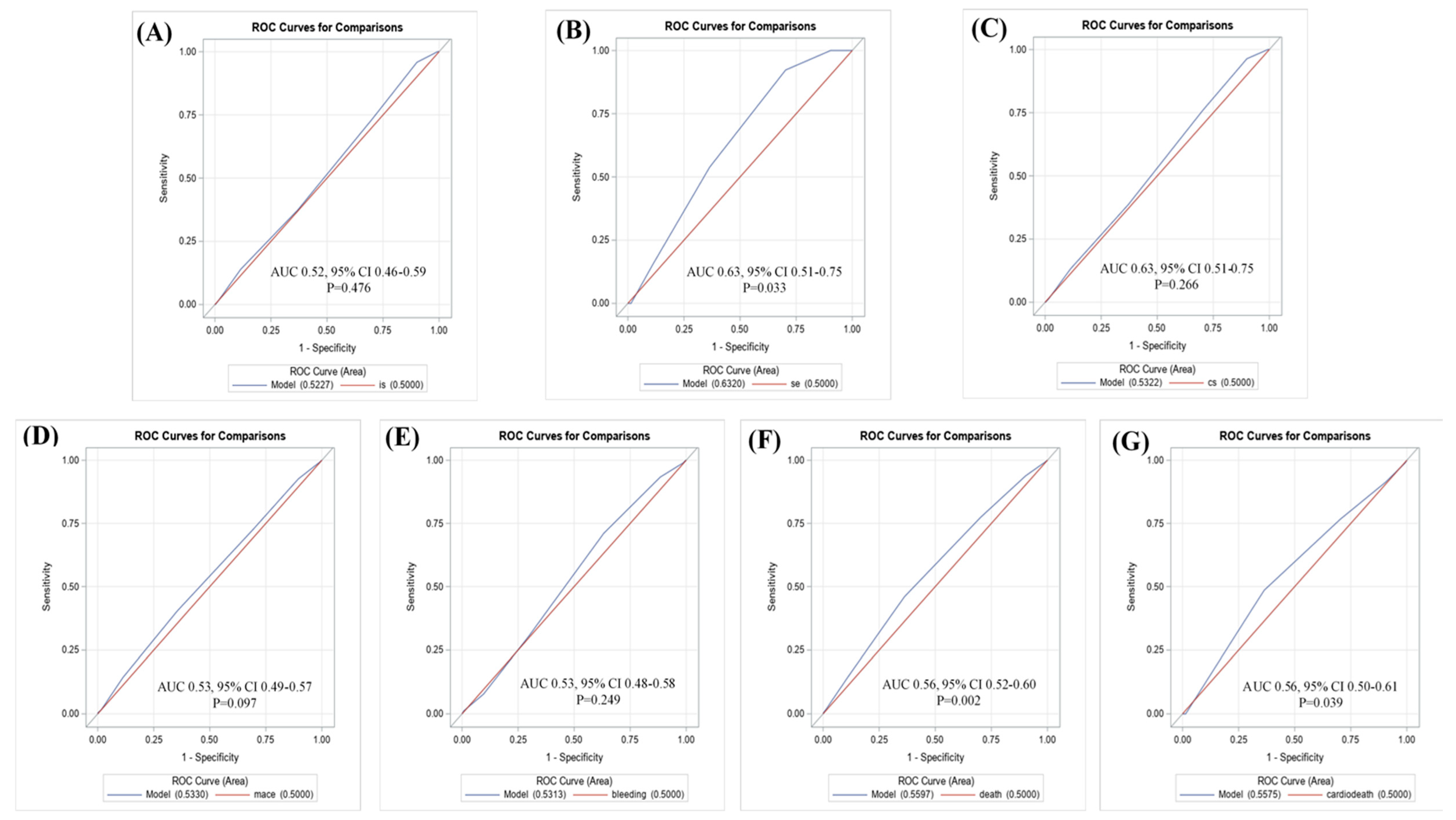Evaluating Effectiveness and Safety in Chronic Kidney Disease with Atrial Flutter Using an Anticoagulation Strategy
Abstract
1. Introduction
2. Materials and Methods
2.1. Data Sources
2.2. Study Sample
2.3. Medication Use
2.4. Outcomes
2.5. Statistics
3. Results
3.1. Study Population Included in the Study
3.2. Demographic Characteristics of Study Populations
3.3. Outcome Analysis of Study Population
3.4. Stroke risk Stratified with CHA2DS2-VASc Score and Gender
4. Discussion
4.1. Effectiveness and Safety of Different Oral Antithrombotic Regimens for Stroke Prevention
4.2. Subgroup Analysis to Stratify Event Risk by CHA2DS2-VASc Score and Gender
4.3. Study Strengths and Limitations
5. Conclusions
Supplementary Materials
Author Contributions
Funding
Acknowledgments
Conflicts of Interest
References
- Hwang, S.J.; Tsai, J.C.; Chen, H.C. Epidemiology, impact and preventive care of chronic kidney disease in Taiwan. Nephrology 2010, 15, 3–9. [Google Scholar] [CrossRef] [PubMed]
- Wen, C.P.; Cheng, T.Y.D.; Tsai, M.K.; Chang, Y.C.; Chan, H.T.; Tsai, S.P.; Chiang, P.H.; Hsu, C.C.; Sung, P.K.; Hsu, Y.H.; et al. All-cause mortality attributable to chronic kidney disease: A prospective cohort study based on 462 293 adults in Taiwan. Lancet 2008, 371, 2173–2182. [Google Scholar] [CrossRef]
- Albertsen, I.E.; Rasmussen, L.H.; Overvad, T.F.; Graungaard, T.; Larsen, T.B.; Lip, G.Y. Risk of stroke or systemic embolism in atrial fibrillation patients treated with warfarin: A Systematic review and meta-analysis. Stroke 2013, 44, 1329–1336. [Google Scholar] [CrossRef] [PubMed]
- Olesen, J.B.; Lip, G.Y.; Kamper, A.; Hommel, K.; Køber, L.; Lane, D.A.; Lindhardsen, J.; Gislason, G.; Torp-Pedersen, C. Stroke and bleeding in atrial fibrillation with chronic kidney disease. N. Engl. J. Med. 2012, 367, 625–635. [Google Scholar] [CrossRef]
- Heine, G.H.; Brandenburg, V.; Schirmer, S.H. Oral anticoagulation in chronic kidney disease and atrial fibrillation. Dtsch. Arztebl. Int. 2018, 115, 287–294. [Google Scholar] [CrossRef]
- Al-Kawaz, M.; Omran, S.S.; Parikh, N.S.; Elkind, M.S.; Soliman, E.Z.; Kamel, H. Comparative risks of ischemic stroke in atrial flutter versus atrial fibrillation. J. Stroke Cerebrovasc. Dis. 2018, 27, 839–844. [Google Scholar] [CrossRef]
- Chen, Y.L.; Lin, Y.S.; Wang, H.T.; Liu, W.H.; Chen, H.C.; Chen, M.C. Clinical outcomes of solitary atrial flutter patients using anticoagulation therapy: A national cohort study. Europace 2019, 21, 313–321. [Google Scholar] [CrossRef]
- Aksu, H.U.; Oner, E.; Erturk, M.; Aksu, H.; Isıksacan, N.; Ozalp, B.; Akture, G.; Akbay, E.; Ozer, L.; Erol, M.K. Aspirin resistance in patients with impaired renal functions. Kardiol. Pol. 2014, 72, 331–338. [Google Scholar] [CrossRef]
- Kaufman, J.S.; Fiore, L.; Hasbargen, J.A.; O’Connor, T.Z.; Perdriset, G. A pharmacodynamic study of clopidogrel in chronic hemodialysis patients. J. Thromb. Thrombolysis 2000, 10, 127–131. [Google Scholar] [CrossRef]
- Tanrikulu, A.M.; Ozben, B.; Koc, M.; Papila-Topal, N.; Ozben, T.; Caymaz, O. Aspirin resistance in patients with chronic renal failure. J. Nephrol. 2011, 24, 636–646. [Google Scholar] [CrossRef]
- Deng, J.; Han, Y.; Wang, X.Z.; Zhao, X.; Zhang, H.; Zhou, T.N. Effects of chronic kidney disease on platelet response to antiplatelet therapy in acute myocardial infarction patients. Zhonghua Yi Xue Za Zhi 2012, 92, 2674–2676. [Google Scholar] [CrossRef]
- Htun, P.; Fateh-Moghadam, S.; Bischofs, C.; Banya, W.; Müller, K.; Bigalke, B.; Stellos, K.; May, A.E.; Flather, M.; Gawaz, M.; et al. Low responsiveness to clopidogrel increases risk among CKD patients undergoing coronary intervention. J. Am. Soc. Nephrol. 2011, 22, 627–633. [Google Scholar] [CrossRef] [PubMed]
- Jun, M.; James, M.T.; Manns, B.J.; Quinn, R.R.; Ravani, P.; Tonelli, M.; Perkovic, V.; Winkelmayer, W.C.; Ma, Z.; Hemmelgarn, B. The association between kidney function and major bleeding in older adults with atrial fibrillation starting warfarin treatment: Population based observational study. BMJ 2015, 350, h246. [Google Scholar] [CrossRef] [PubMed]
- Dentali, F.; Douketis, J.D.; Lim, W.; Crowther, M. Combined aspirin–oral anticoagulant therapy compared with oral anticoagulant therapy alone among patients at risk for cardiovascular disease. Arch. Intern. Med. 2007, 167, 117–124. [Google Scholar] [CrossRef] [PubMed]
- Flaker, G.C.; Gruber, M.; Connolly, S.J.; Goldman, S.; Chaparro, S.; Vahanian, A.; Halinen, M.O.; Horrow, J.; Halperin, J.L. Risks and benefits of combining aspirin with anticoagulant therapy in patients with atrial fibrillation: An exploratory analysis of stroke prevention using an oral thrombin inhibitor in atrial fibrillation (SPORTIF) trials. Am. Heart J. 2006, 152, 967–973. [Google Scholar] [CrossRef]
- Lamberts, M.; Gislason, G.; Lip, G.Y.; Lassen, J.; Olesen, J.B.; Mikkelsen, A.P.; Sørensen, R.; Køber, L.; Torp-Pedersen, C.; Hansen, M.L. Antiplatelet therapy for stable coronary artery disease in atrial fibrillation patients taking an oral anticoagulant: A nationwide cohort study. Circulation 2014, 129, 1577–1585. [Google Scholar] [CrossRef]
- Steinberg, B.A.; Kim, S.; Piccini, J.P.; Fonarow, G.C.; Lopes, R.D.; Thomas, L.; Ezekowitz, M.D.; Ansell, J.; Kowey, P.; Singer, D.E.; et al. Use and associated risks of concomitant aspirin therapy with oral anticoagulation in patients with atrial fibrillation: Insights from the Outcomes Registry for Better Informed Treatment of Atrial Fibrillation (ORBIT-AF) Registry. Circulation 2013, 128, 721–728. [Google Scholar] [CrossRef]
- Verdoia, M.; Barbieri, L.; Nardin, M.; Suryapranata, H.; De Luca, G. Dual versus single antiplatelet regimen with or without anticoagulation in transcatheter aortic valve replacement: Indirect comparison and meta-analysis. Rev. Esp. Cardiol. 2018, 71, 257–266. [Google Scholar] [CrossRef] [PubMed]
- Wong, K.S.; Leng, X.; Mao, C.; Tang, J.; Bath, P.M.; Markus, H.S.; Gorelick, P.B.; Liu, L.; Lin, W.; Wang, Y. Early dual versus mono antiplatelet therapy for acute non-cardioembolic ischemic stroke or transient ischemic attack: An updated systematic review and meta-analysis. Circulation 2013, 128, 1656–1666. [Google Scholar] [CrossRef] [PubMed]
- Hansen, M.L.; Sørensen, R.; Clausen, M.T.; Fog-Petersen, M.L.; Raunsø, J.; Gadsbøll, N.; Gislason, G.; Folke, F.; Andersen, S.S.; Schramm, T.K.; et al. Risk of bleeding with single, dual, or triple therapy with warfarin, aspirin, and clopidogrel in patients with atrial fibrillation. Arch. Intern. Med. 2010, 170, 1433–1441. [Google Scholar] [CrossRef] [PubMed]
- Hamon, M.; Lemesle, G.; Tricot, O.; Meurice, T.; DeNeve, M.; Dujardin, X.; Brufau, J.M.; Bera, J.; Lamblin, N.; Bauters, C. Incidence, source, determinants, and prognostic impact of major bleeding in outpatients with stable coronary artery disease. J. Am. Coll. Cardiol. 2014, 64, 1430–1436. [Google Scholar] [CrossRef]
- Lin, Y.S.; Chen, Y.L.; Chen, T.H.; Lin, M.S.; Liu, C.H.; Yang, T.Y.; Chung, C.M.; Chen, M.C. Comparison of clinical outcomes among patients with atrial fibrillation or atrial flutter stratified by CHA2DS2-VASc Score. JAMA Netw. Open 2018, 1, e180941. [Google Scholar] [CrossRef] [PubMed]
- Gage, B.F.; Van Walraven, C.; Pearce, L.; Hart, R.G.; Koudstaal, P.J.; Boode, B.; Petersen, P. Selecting patients with atrial fibrillation for anticoagulation. Circulation 2004, 110, 2287–2292. [Google Scholar] [CrossRef] [PubMed]
- Sawaya, F.J.; Morice, M.C.; Spaziano, M.; Mehran, R.; Didier, R.; Roy, A.; Valgimigli, M.; Kim, H.S.; Park, K.; Hong, M.K.; et al. Short-versus long-term dual antiplatelet therapy after drug-eluting stent implantation in women versus men: A sex-specific patient-level pooled-analysis of six randomized trials. Catheter. Cardiovasc. Interv. 2016, 89, 178–189. [Google Scholar] [CrossRef] [PubMed]
- Mazurek, M.; Huisman, M.V.; Rothman, K.J.; Paquette, M.; Teutsch, C.; Diener, H.C.; Dubner, S.J.; Halperin, J.L.; Zint, K.; França, L.R.; et al. Gender differences in antithrombotic treatment for newly diagnosed atrial fibrillation: The GLORIA-AF registry program. Am. J. Med. 2018, 131, 945–955. [Google Scholar] [CrossRef] [PubMed]
- Romano, S.; Buccheri, S.; Mehran, R.; Angiolillo, D.J.; Capodanno, D. Gender differences on benefits and risks associated with oral antithrombotic medications for coronary artery disease. Expert Opin. Drug Saf. 2018, 17, 1041–1052. [Google Scholar] [CrossRef]
- Meschia, J.F.; Bushnell, C.; Boden-Albala, B.; Braun, L.T.; Bravata, D.M.; Chaturvedi, S.; Creager, M.A.; Eckel, R.H.; Elkind, M.S.; Fornage, M.; et al. Guidelines for the primary prevention of stroke. Stroke 2014, 45, 3754–3832. [Google Scholar] [CrossRef]



| Characteristics | APT | OAC | Combination | p-Value |
|---|---|---|---|---|
| n = 483 | n = 249 | n = 113 | ||
| Age, mean (SD), years | 70.78 (11.29) | 71.30 (10.91) | 69.94 (11.02) | 0.557 |
| Age group (%) | ||||
| <65 | 135 (27.95) | 57 (22.89) | 34 (30.09) | 0.874 |
| 65–74 | 144 (29.81) | 72 (28.92) | 37 (32.74) | |
| ≥75 | 204 (42.24) | 109 (43.78) | 42 (37.17) | |
| Gender (%) | ||||
| Male | 330 (68.32) | 185 (74.30) | 89 (78.76) | 0.044 |
| Female | 153 (31.68) | 64 (25.70) | 24 (21.24) | |
| Comorbidity (%) | ||||
| Congestive heart failure | 109 (22.57) | 54 (21.69) | 33 (29.20) | 0.257 |
| Hypertension | 294 (60.87) | 140 (56.22) | 71 (62.83) | 0.371 |
| Diabetes mellitus | 219 (45.34) | 92 (36.95) | 55 (48.67) | 0.044 |
| Vascular disease | 35 (7.25) | 3 (1.20) | 34 (30.09) | <0.001 |
| Chronic obstructive pulmonary disease | 39 (8.07) | 17 (6.83) | 12 (10.62) | 0.470 |
| Dyslipidemia | 87 (18.01) | 43 (17.27) | 27 (23.89) | 0.287 |
| Gout | 59 (12.22) | 28 (11.24) | 10 (8.85) | 0.595 |
| Abnormal liver function | 53 (10.97) | 19 (7.63) | 6 (5.31) | 0.101 |
| Gastric ulcer | 50 (10.35) | 19 (7.63) | 10 (8.85) | 0.479 |
| Bleeding history | 50 (10.35) | 21 (8.43) | 11 (9.73) | 0.708 |
| Concomitant drugs (%) | ||||
| Beta blocker | 287 (59.42) | 169 (67.87) | 83 (73.45) | 0.006 |
| CCB | 297 (61.49) | 124 (49.80) | 71 (62.83) | 0.006 |
| ACEI/ARB | 214 (44.31) | 126 (50.60) | 63 (55.75) | 0.050 |
| Amiodarone | 192 (39.75) | 104 (41.77) | 64 (56.64) | 0.005 |
| Statin | 155 (32.09) | 71 (28.51) | 59 (52.21) | <0.001 |
| Digoxin | 69 (14.29) | 48 (19.28) | 20 (17.70) | 0.199 |
| NSAID | 306 (63.35) | 140 (56.22) | 78 (69.03) | 0.044 |
| PPI | 80 (16.56) | 22 (8.84) | 33 (29.20) | <0.001 |
| H2-blocker | 104 (21.53) | 45 (18.07) | 33 (29.20) | 0.058 |
| CHA2DS2-VASc score, mean (SD) | 3.05 (1.29) | 2.82 (1.09) | 3.26 (1.27) | 0.004 |
| HAS-BLED score, mean (SD) | 3.51 (0.80) | 2.44 (0.75) | 3.45 (0.73) | <0.001 |
| Crude Hazard Ratio | Adjusted Hazard Ratio | |||||||||||
|---|---|---|---|---|---|---|---|---|---|---|---|---|
| APT vs. Combination | OAC vs. Combination | APT vs. OAC | APT vs. Combination | OAC vs. Combination | APT vs. OAC | |||||||
| 95% CI | p-Value | 95% CI | p-Value | 95% CI | p-Value | 95% CI | p-value | 95% CI | p-Value | 95% CI | p-Value | |
| Ischemic stroke | 0.61 (0.24–1.57) | 0.307 | 0.66 (0.23–1.91) | 0.448 | 1.04 (0.46–2.34) | 0.924 | 0.54 (0.21–1.44) | 0.222 | 0.58 (0.18–1.87) | 0.361 | 1.07 (0.47–2.46) | 0.873 |
| Systemic embolism | 0.09 (0.01–1.10) | 0.059 | 0.26 (0.02–2.95) | 0.277 | 0.55 (0.03–8.80) | 0.672 | 0.06 (0.00–1.67) | 0.097 | 0.29 (0.02–3.65) | 0.335 | 0.33 (0.02–6.68) | 0.467 |
| Composite of stroke | 0.42 (0.18–1.00) | 0.051 | 0.56 (0.22–1.45) | 0.235 | 0.89 (0.40–1.95) | 0.761 | 0.42 (0.18–1.01) | 0.051 | 0.63 (0.22–1.82) | 0.390 | 0.91 (0.40–2.06) | 0.819 |
| MACE | 0.89 (0.45–1.79) | 0.747 | 0.64 (0.29–1.41) | 0.269 | 1.40 (0.81–2.42) | 0.234 | 0.93 (0.46–1.89) | 0.850 | 0.71 (0.30–1.67) | 0.436 | 1.34 (0.76–2.36) | 0.315 |
| Major bleeding | 0.93 (0.31–2.75) | 0.895 | 1.44 (0.46–4.47) | 0.533 | 0.86 (0.44–1.68) | 0.652 | 0.97 (0.33–2.87) | 0.957 | 1.19 (0.37–3.84) | 0.775 | 0.91 (0.46–1.80) | 0.779 |
| All-cause mortality | 0.73 (0.42–1.27) | 0.266 | 0.22 (0.10–0.49) | <0.001 | 2.88 (1.51–5.49) | 0.001 | 0.86 (0.49–1.51) | 0.596 | 0.24 (0.10–0.55) | 0.001 | 2.86 (1.48–5.53) | 0.002 |
| Cardiovascular-related death | 0.69 (0.34–1.42) | 0.318 | 0.23 (0.08–0.64) | 0.005 | 2.88 (1.20–6.90) | 0.018 | 0.79 (0.38–1.66) | 0.530 | 0.24 (0.08–0.73) | 0.012 | 2.60 (1.06–6.36) | 0.037 |
| Crude Hazard Ratio | Adjusted Hazard Ratio | |||||||||||
|---|---|---|---|---|---|---|---|---|---|---|---|---|
| APT vs. Combination | OAC vs. Combination | APT vs. OAC | APT vs. Combination | OAC vs. Combination | APT vs. OAC | |||||||
| Subgroup | 95% CI | p-Value | 95% CI | p-Value | 95% CI | p-Value | 95% CI | p-Value | 95% CI | p-Value | 95% CI | p-Value |
| Ischemic stroke | ||||||||||||
| CHA2DS2-VASc | ||||||||||||
| <5 | 0.81 (0.27–2.48) | 0.713 | 0.85 (0.25–2.89) | 0.794 | 1.07 (0.46–2.54) | 0.870 | 0.78 (0.25–2.44) | 0.665 | 0.93 (0.22–3.95) | 0.926 | 1.12 (0.46–2.74) | 0.799 |
| ≥5 | 0.20 (0.02–1.66) | 0.135 | 0.35 (0.03–3.90) | 0.390 | 0.84 (0.08–9.32) | 0.890 | 0.19 (0.02–1.72) | 0.139 | 0.31 (0.03–3.66) | 0.353 | 0.81 (0.05–14.34) | 0.886 |
| Systemic embolism | ||||||||||||
| CHA2DS2-VASc | ||||||||||||
| <5 | - | - | - | - | - | - | - | - | - | - | - | - |
| ≥5 | 0.10 (0.01–2.04) | 0.134 | - | - | - | - | 0.11 (0.01–2.21) | 0.149 | - | - | - | - |
| Composite of stroke | ||||||||||||
| CHA2DS2-VASc | ||||||||||||
| <5 | 0.60 (0.21–1.68) | 0.327 | 0.80 (0.26–2.44) | 0.693 | 0.89 (0.39–2.06) | 0.788 | 0.60 (0.21–1.74) | 0.349 | 0.98 (0.26–3.78) | 0.981 | 0.93 (0.39–2.24) | 0.876 |
| ≥5 | 0.11 (0.02–0.84) | 0.033 | 0.20 (0.02–1.92) | 0.161 | 0.87 (0.08–9.61) | 0.910 | 0.23 (0.01–6.95) | 0.399 | 0.19 (0.02–1.91) | 0.156 | 0.81 (0.05–14.34) | 0.886 |
| MACE | ||||||||||||
| CHA2DS2-VASc | ||||||||||||
| <5 | 1.03 (0.46–2.33) | 0.940 | 0.81 (0.33–1.98) | 0.641 | 1.27 (0.71–2.26) | 0.420 | 1.11 (0.49–2.55) | 0.801 | 0.82 (0.32–2.15) | 0.690 | 1.16 (0.64–2.11) | 0.633 |
| ≥5 | 0.66 (0.17–2.55) | 0.546 | 0.24 (0.02–2.29) | 0.213 | 3.27 (0.41–26.13) | 0.265 | 0.43 (0.10–1.90) | 0.265 | 0.12 (0.00–6.47) | 0.297 | 3.73 (0.39–36.03) | 0.255 |
| Major Bleeding | ||||||||||||
| CHA2DS2-VASc | ||||||||||||
| <5 | 1.23 (0.36–4.18) | 0.740 | 1.82 (0.51–6.46) | 0.353 | 0.85 (0.43–1.67) | 0.627 | 1.27 (0.36–4.49) | 0.712 | 1.48 (0.33–6.66) | 0.614 | 0.88 (0.44–1.78) | 0.729 |
| ≥5 | - | - | - | - | - | - | - | - | - | - | - | - |
| All-cause mortality | ||||||||||||
| CHA2DS2-VASc | ||||||||||||
| <5 | 0.69 (0.37–1.26) | 0.222 | 0.26 (0.11–0.57) | 0.001 | 2.30 (1.19–4.45) | 0.014 | 0.82 (0.44–1.54) | 0.538 | 0.32 (0.13–0.78) | 0.012 | 2.15 (1.08–4.25) | 0.029 |
| ≥5 | 1.09 (0.31–3.90) | 0.894 | - | - | - | - | 1.20 (0.30–4.70) | 0.798 | - | - | - | - |
| Cardiovascular-related death | ||||||||||||
| CHA2DS2-VASc | ||||||||||||
| <5 | 0.64 (0.30–1.37) | 0.248 | 0.24 (0.09–0.70) | 0.008 | 2.51 (1.03–6.10) | 0.042 | 0.75 (0.34–1.68) | 0.489 | 0.30 (0.09–0.99) | 0.048 | 2.06 (0.82–5.17) | 0.122 |
| ≥5 | 1.43 (0.17–12.36) | 0.744 | - | - | - | - | 1.41 (0.14–14.64) | 0.772 | - | - | - | - |
© 2020 by the authors. Licensee MDPI, Basel, Switzerland. This article is an open access article distributed under the terms and conditions of the Creative Commons Attribution (CC BY) license (http://creativecommons.org/licenses/by/4.0/).
Share and Cite
Wang, Y.-T.; Chen, C.-Y.; Bair, M.-J. Evaluating Effectiveness and Safety in Chronic Kidney Disease with Atrial Flutter Using an Anticoagulation Strategy. Medicina 2020, 56, 266. https://doi.org/10.3390/medicina56060266
Wang Y-T, Chen C-Y, Bair M-J. Evaluating Effectiveness and Safety in Chronic Kidney Disease with Atrial Flutter Using an Anticoagulation Strategy. Medicina. 2020; 56(6):266. https://doi.org/10.3390/medicina56060266
Chicago/Turabian StyleWang, Ying-Ting, Chung-Yu Chen, and Ming-Jong Bair. 2020. "Evaluating Effectiveness and Safety in Chronic Kidney Disease with Atrial Flutter Using an Anticoagulation Strategy" Medicina 56, no. 6: 266. https://doi.org/10.3390/medicina56060266
APA StyleWang, Y.-T., Chen, C.-Y., & Bair, M.-J. (2020). Evaluating Effectiveness and Safety in Chronic Kidney Disease with Atrial Flutter Using an Anticoagulation Strategy. Medicina, 56(6), 266. https://doi.org/10.3390/medicina56060266





